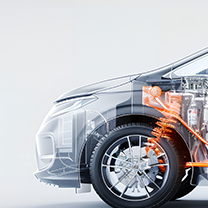
Products
Fast, Reliable, Everywhere

Solutions
Efficient, Innovative EV Charging Solutions.
Electric vehicle (EV) charging involves replenishing the battery by connecting the EV to an external power source. So how do you utilize EV charging Level 1, Level 2, and Rapid DC chargers to transfer power to the vehicle's battery system to power the motor? Understanding these methods is key to effectively maintaining and utilizing your electric vehicle.
EV charging replenishes electric vehicle batteries using three primary methods: Level 1 with standard 120-volt outlets for slow overnight charging, level 2 EV charging 240-volt outlets for faster, more versatile home and public charging, and DC Fast Chargers for the quickest charge on highways. Public charging stations offer various access and payment options through networks, while smart charging optimizes energy use and cost by adjusting to grid demand.
Electric vehicle (EV) charging is the process of adding electrical energy to the rechargeable battery of an EV to replenish its power. Here's how it typically works:
In summary, the key to EV charging is to select the right type of charger for the vehicle's needs, taking into account factors such as daily mileage, vehicle performance, and availability of charging stations.

There are several factors that affect the speed and efficiency of charging electric vehicles (EVs). Understanding these factors can help you manage your EV's charging needs more effectively:
These factors interplay in various ways depending on specific situations and vehicle types, making each charging experience somewhat unique. Proper maintenance and understanding your vehicle’s capabilities and needs can help optimize charging times and battery life.
Electric Vehicle (EV) chargers come in various types, each offering different speeds and levels of convenience. Here are the three primary types of EV chargers used today:
1. Level 1 Chargers
Level 1 chargers utilize a standard 120-volt AC outlet, the same type found in most homes for everyday appliances. This type of charger is the slowest, typically providing about 3 to 5 miles of range per hour of charging, making it suitable for overnight charging or for EVs used minimally, where charging time is not a critical concern. Level 1 charging is an accessible option for users primarily charging at home without the need for additional infrastructure.
2. Level 2 Chargers
Level 2 chargers require a 240-volt AC outlet, which is more robust than standard household outlets and similar to those used for large appliances like ovens and dryers. These chargers offer a much faster charging rate, delivering approximately 12 to 80 miles of range per hour. This makes them ideal for residential and public use, capable of fully charging an EV battery overnight, thus meeting the needs of daily commuting and regular use.
3. DC Fast Chargers (DCFC) or Level 3 Chargers
DC Fast Chargers utilize direct current (DC) and operate at much higher voltages than Level 1 or 2 chargers, enabling them to deliver 60 to 100 miles of range in as little as 20 minutes. These chargers are strategically located in public charging stations along major highways and are essential for long-distance travel, providing a rapid recharge solution that minimizes downtime during trips.
Choosing the right type of charger typically depends on the specific needs of the EV owner, including their typical driving distance, the vehicle's compatibility with fast charging, and the availability of charging

1. Optimize Charging Routine
2. Maintain Battery Health
3. Manage Environmental Conditions
This article describes the basics of electric vehicle (EV) charging, detailing the types, processes, influencing factors, and types of chargers available. Improving EV charging connects the car to an external power source to replenish the battery. Understanding these factors can help optimize the charging experience and maintain battery health.
